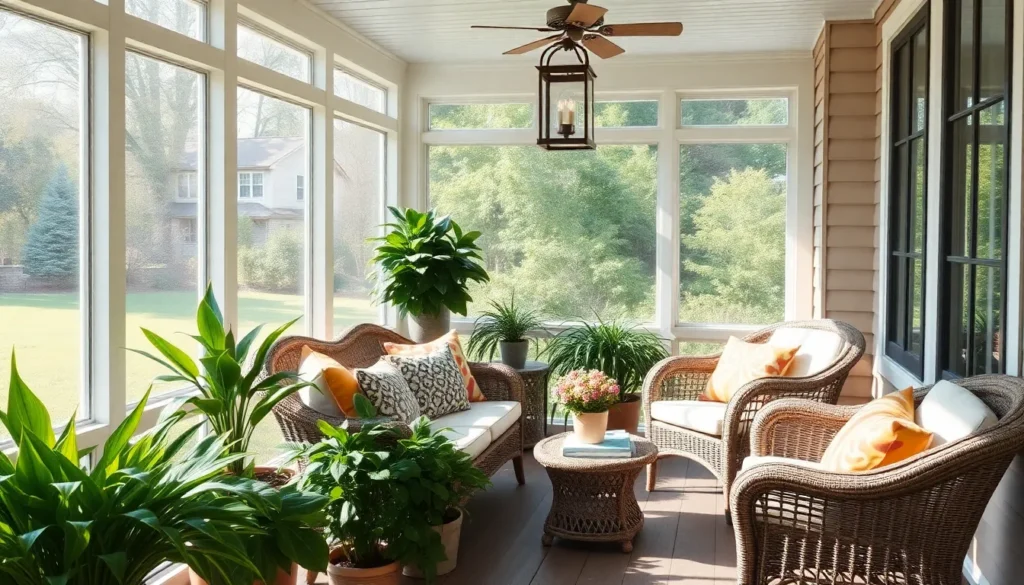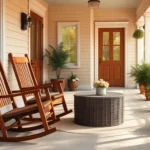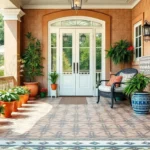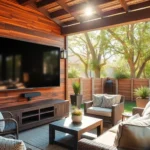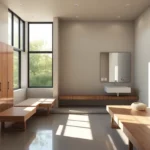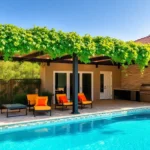Nothing beats the charm of a screened-in front porch – it’s where morning coffee tastes better and evening conversations flow naturally. We’ve discovered that these versatile outdoor spaces offer the perfect balance between indoor comfort and outdoor living while keeping pesky insects at bay.
Transforming your front porch into a screened sanctuary opens up endless possibilities for year-round enjoyment. Whether you’re dreaming of a cozy reading nook complete with hanging plants or an entertainment area that rivals your living room we’ll show you how to create the perfect screened oasis.
From budget-friendly DIY answers to luxurious custom designs we’ve gathered the most inspiring screened-in front porch ideas that’ll make your neighbors envious. These proven concepts will help you maximize your outdoor space while adding important value to your home and creating memories that’ll last a lifetime.
Classic Traditional Screened Front Porch Ideas
Traditional screened front porch designs remain the cornerstone of American home architecture, offering timeless appeal that never goes out of style. These classic approaches blend functionality with enduring elegance to create outdoor spaces that welcome guests and provide comfortable retreats for daily living.
Wrap-Around Porch With White Columns
Wrap-around porches with white columns create the quintessential American home aesthetic that instantly boosts curb appeal. These expansive designs typically extend along two or more sides of the house, providing generous outdoor living space that flows seamlessly from one area to another. We recommend using classic white painted columns in either Doric or Ionic styles, which offer structural support while maintaining visual lightness.
The screening system works best when installed between columns using traditional framing methods that preserve the architectural integrity. Consider adding ceiling fans between column bays to enhance airflow and comfort during warmer months. White wicker furniture and hanging planters complement this style perfectly, creating inviting conversation areas that encourage relaxation and social gatherings.
Colonial Style With Brick Foundation
Colonial style screened porches with brick foundations deliver sophisticated charm that complements traditional home architecture beautifully. These designs feature sturdy brick knee walls that typically rise 24 to 36 inches, topped with screening that extends to the ceiling. The brick foundation provides excellent durability while creating natural separation between indoor and outdoor spaces.
We suggest using matching brick that coordinates with your home’s existing masonry for seamless integration. Traditional black or dark green screening frames work exceptionally well against brick foundations, creating striking contrast that enhances visual appeal. Classic colonial elements like symmetrical layouts and formal proportions ensure these porches maintain their refined appearance for decades.
Farmhouse Design With Wood Railings
Farmhouse design screened porches with wood railings capture rustic charm while providing practical outdoor living answers. These designs emphasize natural materials and simple lines that reflect agricultural heritage and countryside living. Cedar or pressure treated pine railings offer excellent weather resistance while developing beautiful patina over time.
Traditional board and batten siding often extends onto porch walls, creating visual continuity between house and porch structures. We recommend using wider plank flooring in natural wood tones or painted finishes that complement your home’s color scheme. Mason jar lighting fixtures and vintage inspired furniture pieces complete the farmhouse aesthetic, transforming screened areas into cozy retreats that celebrate simple living.
Modern Contemporary Screened Porch Designs
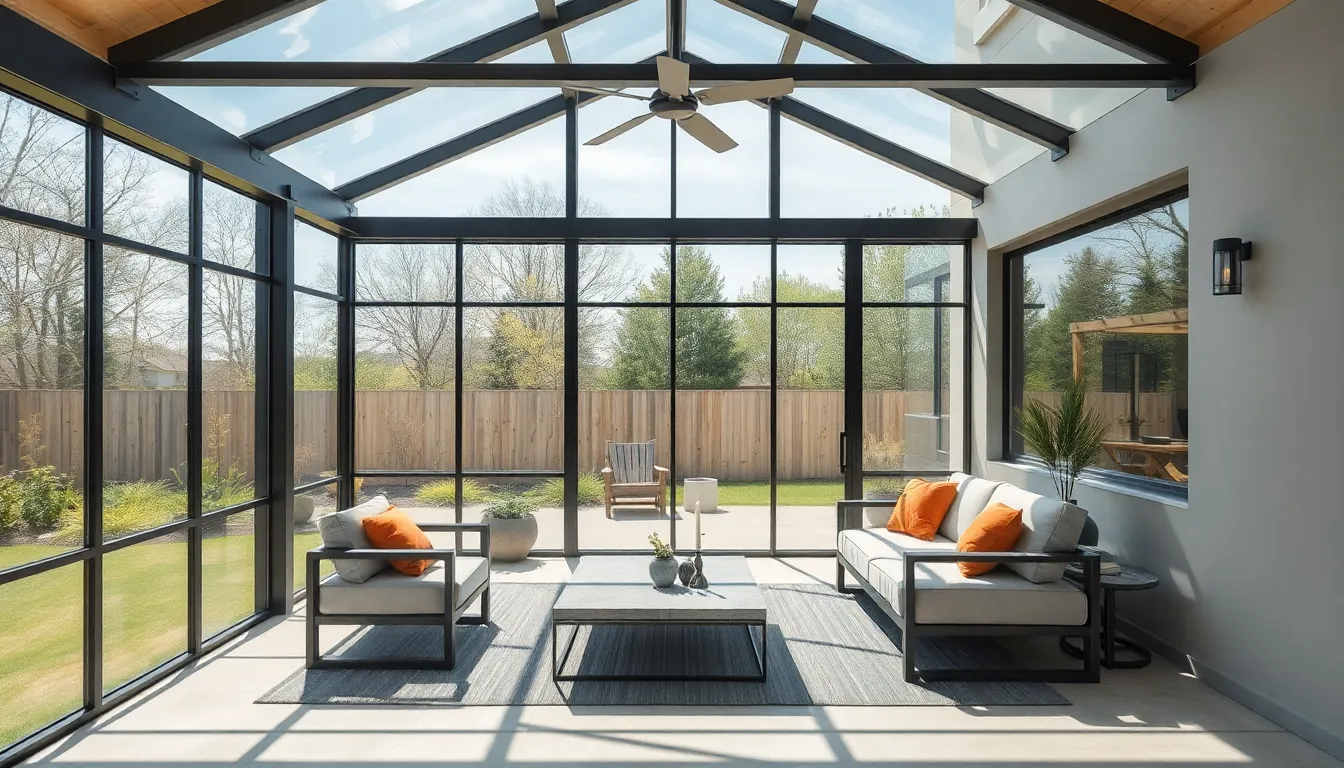
Contemporary screened porches create a striking contrast to traditional designs by embracing sleek aesthetics and innovative materials. We’ll explore how modern elements transform these outdoor spaces into sophisticated extensions of your home.
Minimalist Steel Frame Construction
Steel frames deliver unmatched durability while maintaining the slim profiles that define minimalist design. We recommend these structures for their ability to maximize open views without the visual bulk of traditional wood framing. Minimalist approaches avoid excessive ornamentation and instead celebrate the structural beauty of raw materials.
Contemporary steel supports create an industrial foundation that feels both sturdy and refined. We’ve observed how these frames allow for larger spans between supports, opening up the space dramatically. Clean straight lines become the focal point, emphasizing simplicity over decorative elements.
Clean Lines With Large Glass Panels
Glass panels complement screened areas by flooding the space with natural light while maintaining weather protection. We integrate large windows strategically to create seamless transitions between indoor and outdoor environments. Sharp edges and symmetrical layouts contribute to the calm, orderly aesthetic that modern homeowners crave.
Floor to ceiling glass sections can be combined with screening materials to create hybrid enclosures. We position these panels to frame exact views while preserving the open air feeling. Contemporary installations often feature sliding glass doors that disappear completely when opened.
Industrial Style With Metal Accents
Metal accents in matte black or gunmetal gray provide the visual contrast needed to balance warmth with modern edge. We incorporate raw materials like steel beams, concrete floors, and rough finished wood to achieve authentic industrial character. Vintage lighting fixtures add personality without cluttering the clean aesthetic.
Contemporary industrial porches layer different textures while maintaining a cohesive color palette. We suggest pairing neutral backgrounds with warm accent colors to soften the harder materials. Modern wall decor and strategic lighting placement transform these spaces into sophisticated second living rooms that seamlessly connect with your home’s architecture.
Cozy Cottage Style Screened Front Porches
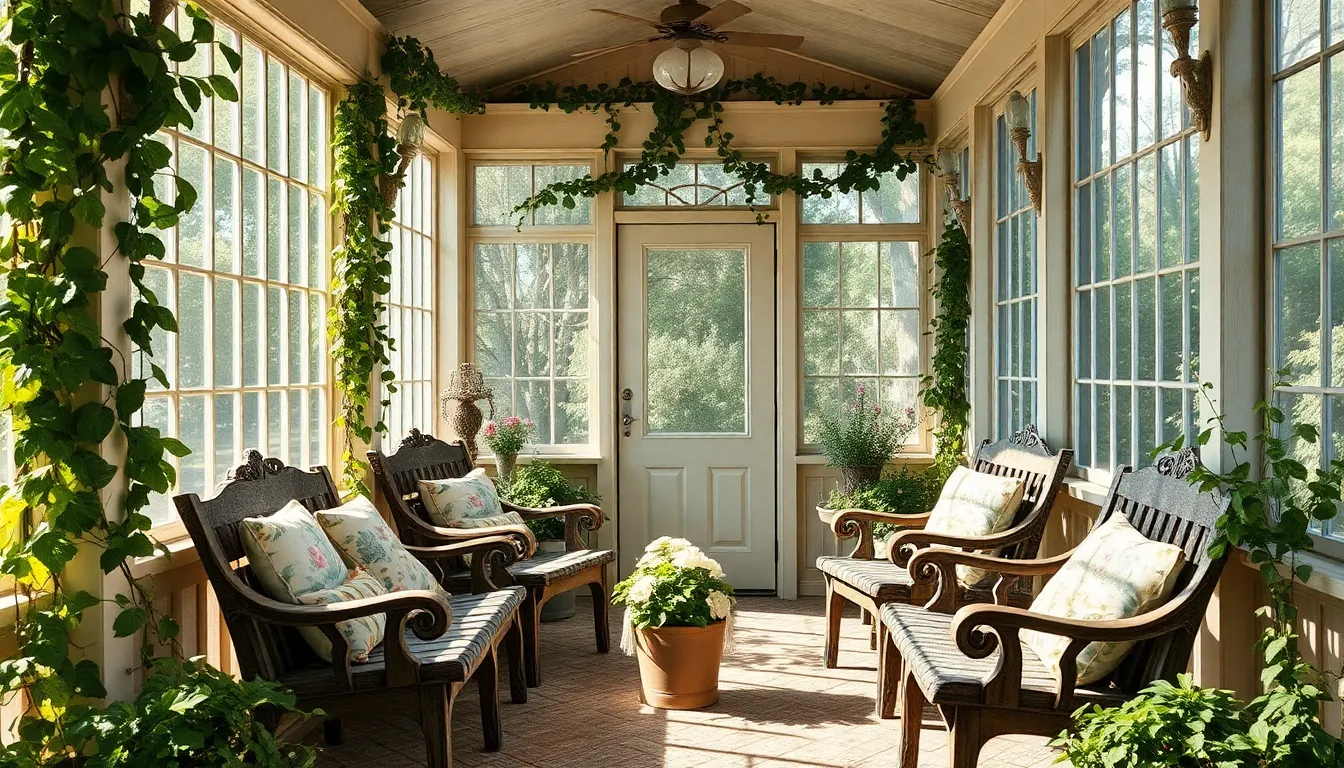
Cottage style screened porches bring warmth and charm to any home through their emphasis on comfort and natural elements. We’ll explore three distinct cottage approaches that transform your front porch into an inviting outdoor retreat.
English Cottage With Climbing Vines
English cottage porches create timeless appeal through charming designs that blend architecture with nature. Climbing plants like ivy or roses add natural beauty while creating an intimate garden atmosphere that feels both classic and romantic.
Wood or wrought iron furniture with floral cushions perfectly complements this vintage aesthetic. We recommend choosing pieces that showcase weathered finishes or distressed details to enhance the cottage character.
Architectural elements such as decorative brackets, lattice screens, and shingled roofs define the English cottage look. These features create visual interest while maintaining the quaint, cozy feeling that makes this style so appealing.
Design elements blur the lines between garden and porch, transforming your space into an intimate outdoor retreat. Strategic placement of climbing vines creates natural privacy screens while adding seasonal color and texture throughout the year.
Beach Cottage With Wicker Furniture
Beach cottage screened porches embrace light, airy aesthetics that capture the essence of coastal living. We focus on creating breezy environments that feel relaxed and casual through careful material and color selections.
Wicker or rattan furniture with cushions in coastal colors like whites, blues, and sandy neutrals enhance the seaside atmosphere. These natural materials withstand humidity while maintaining their charm and comfort over time.
Natural textures including jute rugs, seashell decor, and nautical elements complete the beach cottage look. We suggest incorporating rope details, driftwood accents, and weathered finishes to reinforce the coastal theme.
Wide open screened windows maximize natural light and ocean breezes, creating ideal conditions for relaxation. This design approach transforms your porch into a casual gathering space that feels connected to the outdoors while protecting from insects.
Mountain Cabin Style With Log Beams
Mountain cabin porches feature rustic, rugged elements that create cozy alpine retreats. Exposed log beams and natural wood finishes establish the foundation for this style’s authentic outdoor character.
Heavy wooden rocking chairs or benches with plaid or leather cushions provide comfortable seating that matches the rustic aesthetic. We recommend choosing furniture with substantial construction that reflects the cabin’s sturdy, enduring qualities.
Stone accents and warm lighting through lanterns or sconces add alpine charm while creating inviting evening atmospheres. These elements work together to establish a cozy mountain retreat feeling that’s perfect for enjoying forest or mountain views.
Rustic design elements create sheltered spaces where you can enjoy nature while staying protected from insects and weather. Natural materials and earth tones ensure your mountain cabin porch feels authentic and connected to its surroundings.
Small Space Screened Front Porch Solutions
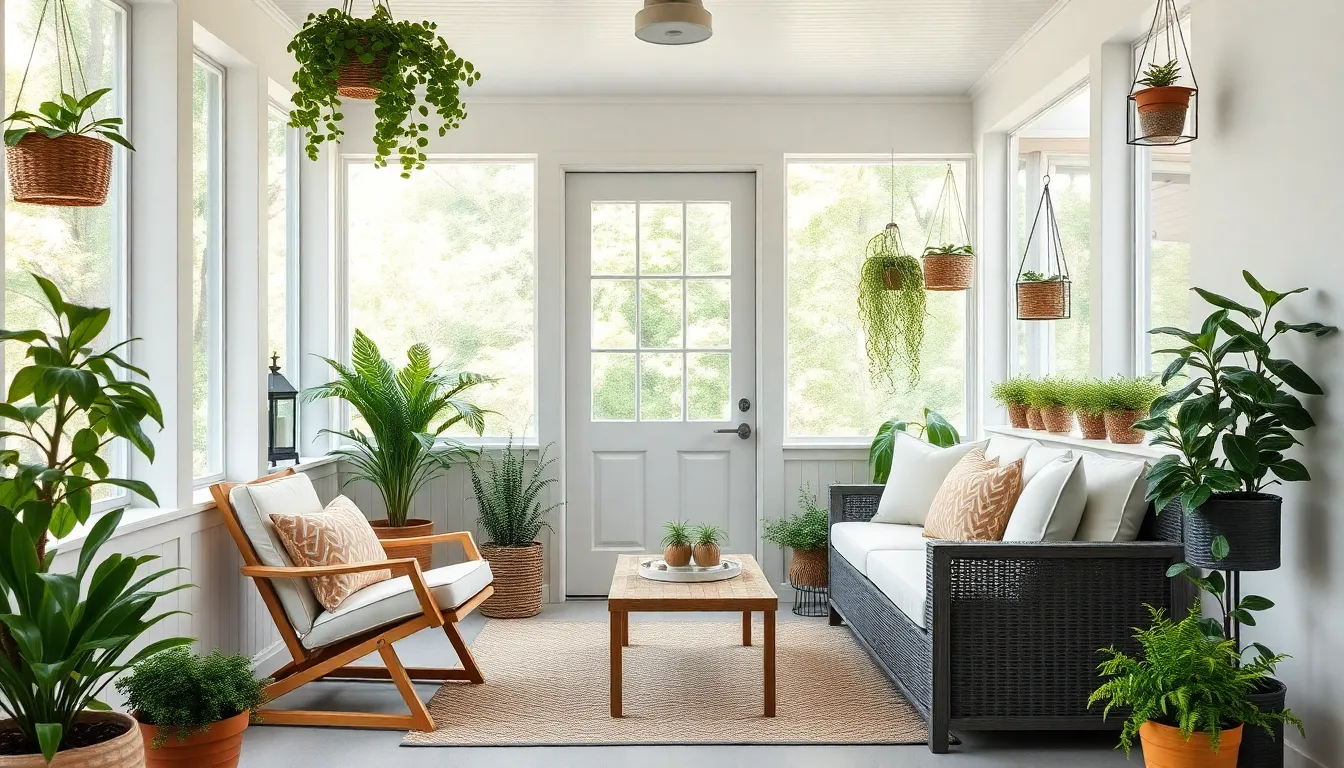
Working with limited square footage doesn’t mean sacrificing style or functionality in your screened front porch design. Smart planning transforms even the smallest spaces into comfortable outdoor retreats.
Space saving furniture choices make the biggest impact in compact screened porches. Folding chairs store easily when not in use, while benches with built-in storage compartments serve double duty by providing seating and hiding cushions or outdoor supplies. Built-in seating maximizes floor area since it doesn’t require walking space around individual pieces.
Multifunctional elements expand your porch’s capabilities without crowding the space. Side tables that convert to plant stands accommodate both drinks and greenery, while storage ottomans provide extra seating when guests visit. Lightweight furniture with colorful cushions creates an inviting atmosphere without overwhelming the limited area.
Vertical design strategies add visual interest while preserving precious floor space. Hanging plants cascade beautifully from ceiling hooks or wall brackets, while vertical planters climb walls to create living privacy screens. Wall mounted fixtures keep surfaces clear for activities and movement.
Color choices dramatically affect how spacious your small porch feels. Light color palettes in whites, creams, and soft pastels reflect natural light and create an airy atmosphere. Neutral tones help furniture blend together rather than competing for attention in the confined space.
Compact Corner Porch Ideas
Corner transformation turns awkward angles into the most coveted spots on your screened porch. Cushioned built-in benches wrap around corners to create intimate conversation nooks that feel separate from main traffic flow. Corner loungers with plush cushions become perfect reading retreats where you can curl up with a book.
Corner utility features maximize functionality in these often underused spaces. Corner shelves display plants, books, or decorative items without protruding into walkways. Corner mounted lighting fixtures provide focused illumination for reading or evening conversations while keeping the ceiling clear.
Privacy screening makes corner areas feel like private sanctuaries within your porch. Strategic screen placement creates enclosed nooks that offer protection from bugs and wind. Drop-down screens can section off corners when privacy is desired but retract when you want an open feel.
Flexible furniture answers adapt to your corner’s changing needs. Small folding tables appear when you need surface space for drinks or snacks, then disappear for floor activities or cleaning. Drop-leaf tables mount to corner walls and fold flat when not serving meals or games.
Narrow Porch Maximization Tips
Strategic seating placement keeps narrow porches functional and safe. Aligning all seating against one wall preserves the walkway for foot traffic and emergency access. This arrangement also creates a unified look that makes the space appear more organized and intentional.
Slim profile furniture fits narrow spaces without sacrificing comfort. Slender rocking chairs provide traditional porch charm while taking up minimal width. Narrow benches offer seating for multiple people without extending far into the walkway, and their linear shape emphasizes the porch’s length rather than its limited width.
Wall mounted answers eliminate the need for floor space entirely. Fold-away tables mount to walls and flip up when you need dining or work surfaces, then fold down flush against the wall. Wall mounted shelves display plants and decorative items without any floor footprint.
Visual lengthening techniques make narrow porches feel more spacious. Long, narrow rugs emphasize the porch’s length and create a defined pathway that guides the eye along the space. Horizontal design elements like long planters or extended lighting fixtures draw attention to the porch’s best dimension.
Vertical emphasis draws the eye upward to make narrow spaces feel taller and more open. Hanging plants create layers of greenery at different heights, while vertical wall art adds visual interest without using floor space. String lights hung vertically between posts create dramatic lighting effects that emphasize height.
Multi-Level Small Porch Designs
Staggered level zones create distinct areas within compact screened porches. Upper levels accommodate seating areas with chairs and small tables, while lower sections house planters or compact dining nooks. This vertical separation makes small porches feel larger by creating multiple functional spaces.
Built-in planter railings add greenery without sacrificing floor space on any level. Railing systems with integrated planter boxes create living boundaries between levels while providing space for flowers, herbs, or small shrubs. Ledge style railings offer surfaces for potted plants that can be rearranged seasonally.
Layered lighting design defines each level while creating beautiful ambiance. String lights illuminate upper seating areas with soft, romantic glow, while lanterns on lower levels provide focused task lighting for dining or reading. Different lighting types help each level feel like its own distinct outdoor room.
Unified material choices tie multiple levels together visually while adding texture and warmth. Composite decking creates consistent flooring across all levels with minimal maintenance requirements. Wood accents on railings, posts, or built-ins add natural warmth that complements the composite materials and creates a cohesive design throughout the multi-level space.
Luxury High-End Screened Front Porch Concepts
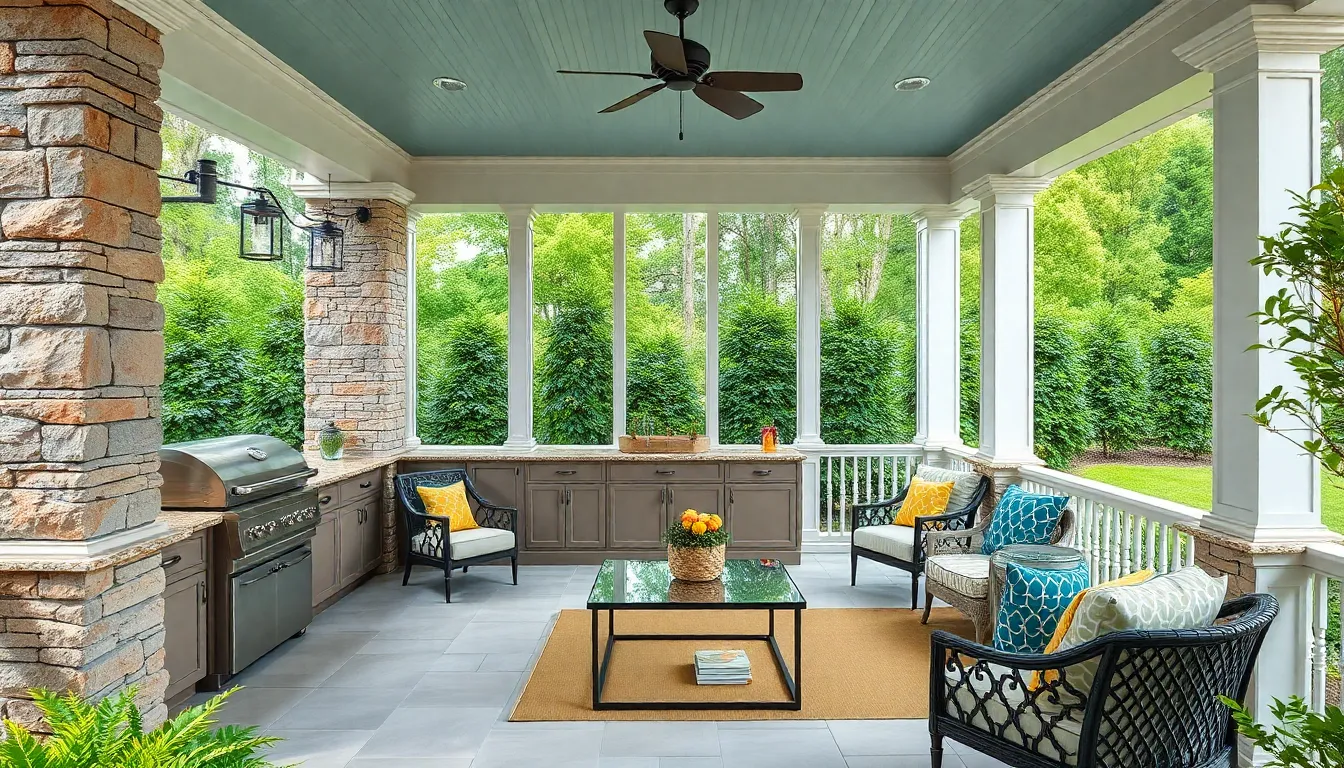
Elevating your screened front porch to luxury status transforms it from simple outdoor space into an impressive architectural statement. These premium designs showcase sophisticated materials and resort quality features that rival high end interior rooms.
Grand Entrance With Stone Pillars
Stone pillars create the ultimate first impression with their stately presence and timeless architectural appeal. We’ve found that stone clad façades paired with covered screened porches provide both welcoming transition spaces and sophisticated architectural anchors that enhance curb appeal dramatically.
Natural materials like stone and wood blend beautifully to create elegant yet grounded aesthetics that complement rustic or provincial home designs. Provincial style homes especially benefit from this approach because the stone foundation creates visual weight that balances the lighter screened elements above.
Stone construction offers durability advantages that make it ideal for grand entrances exposed to weather elements year round. Weather resistance combined with the material’s natural beauty ensures your investment maintains its impressive appearance for decades without requiring frequent maintenance updates.
Resort-Style With Outdoor Kitchen
Outdoor kitchens elevate screened porches into luxurious entertainment destinations that rival any resort experience. Built in barbecue centers anchor these spaces while spacious seating arrangements create perfect environments for hosting family gatherings and social events.
Weather resistant materials enable year round functionality that extends your home’s living space regardless of season or climate conditions. Gourmet cooking facilities combined with bug free dining areas provide the ultimate outdoor entertaining experience that guests will remember long after they leave.
Resort quality features transform these porches into extensions of indoor living spaces where cooking, dining, and socializing happen seamlessly. Entertainment areas designed with professional grade appliances and comfortable seating ensure every gathering feels like a luxury vacation experience.
Executive Home With Premium Materials
Premium materials define executive level screened porches through carefully selected elements like high end wood cabinetry and faux finished walls. Fine textiles and locally crafted furnishings create seamless indoor outdoor flow that reflects sophisticated design sensibilities and attention to detail.
Performance fabrics in bright or daring patterns allow these spaces to maintain both style and practicality throughout changing seasons. Rattan chairs featuring durable textiles provide flexibility while maintaining the luxury aesthetic that executive homes demand from every design element.
Floor to ceiling doors create expansive, uninterrupted living areas that connect porch spaces seamlessly to indoor rooms. Timeless textiles combined with vintage or antique pieces add character and historical depth that makes these porches feel both current and collected over time.
| Luxury Feature | Material Options | Design Benefits |
|---|---|---|
| Stone Pillars | Natural stone, cultured stone | Enhanced curb appeal, architectural anchor |
| Outdoor Kitchens | Stainless steel, weather resistant wood | Year round functionality, entertainment hub |
| Premium Finishes | High end cabinetry, performance fabrics | Sophisticated aesthetics, durability |
Budget-Friendly DIY Screened Porch Projects
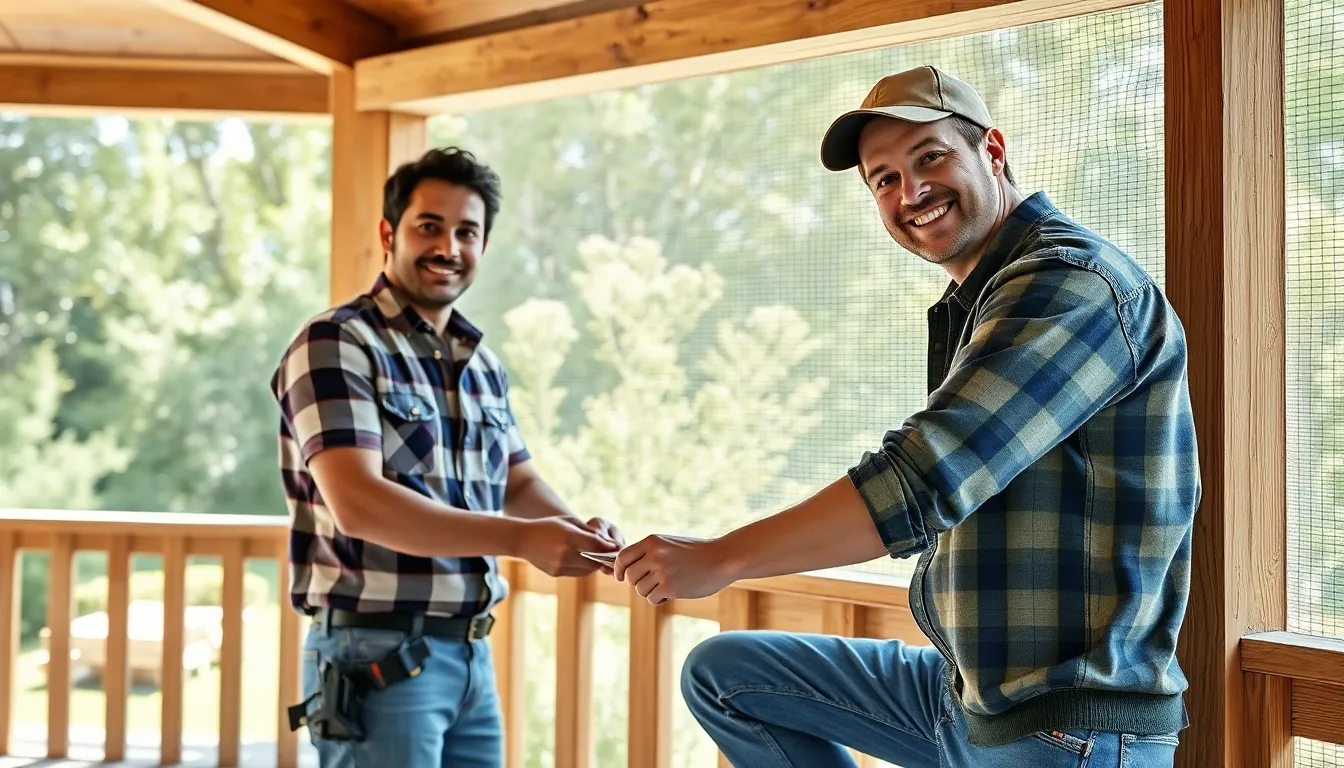
Creating a screened porch doesn’t have to expensive. We’ve found that DIY projects under $500 are entirely achievable with smart planning and efficient material use.
Simple Screen Installation Methods
Spline screen installation offers the most straightforward approach for DIY enthusiasts. We recommend starting by installing tracks or channels directly onto your existing porch studs using standard wood screws. Cutting these tracks to size requires only basic tools like pruning shears or tin snips.
Stretching fiberglass screening comes next, where we pull the material taut across the frame opening. The key lies in maintaining consistent tension throughout the installation process. We then press rubber spline tubing into the track over the screen using a specialized spline roller, which secures everything in place.
Trimming excess material happens last, using a sharp utility knife to cut away any overhang. We finish by adding vinyl trim caps to protect the edges and create a professional appearance. This entire process typically takes about one day for an average sized porch when working with standard 2×4 or 4×4 framing.
Affordable Material Alternatives
Fiberglass screening stands out as our top choice for budget conscious projects. This material combines durability with affordability while remaining easy to handle during installation. We’ve found it performs exceptionally well in various weather conditions without requiring frequent replacement.
Standard lumber framing using 2x4s or 4x4s significantly reduces material costs compared to specialty porch materials. These common dimensions are readily available at most home improvement stores and work perfectly with standard screening systems.
Basic hardware components like wood screws, staples, and vinyl trim caps cost far less than premium alternatives. We source these items from local hardware stores where bulk purchasing can further reduce expenses. Aluminum trim caps provide excellent weather resistance at a fraction of the cost of custom millwork.
Cost-Saving Construction Tips
Reusing existing porch framing eliminates the largest expense in most screening projects. We carefully remove old screens while preserving the structural elements, then adapt our new screening system to work with what’s already there.
Purchasing screening kits that include tracks, spline, and caps together costs less than buying components separately. We’ve found these kits often include enough material for small to medium sized porches while providing better value than individual purchases.
Working in phases allows us to spread expenses over time while avoiding the need for hired labor. We tackle one section at a time, completing the installation process gradually as budget allows. This approach also reduces the risk of material waste since we can adjust our purchasing based on actual needs.
Using simple tools keeps equipment costs minimal. A utility knife, pruning shears, rubber mallet, and basic screwdrivers handle most installation tasks. We don’t need precision cuts or complex mitering since tracks can be cut roughly without affecting the installation’s effectiveness.
Seasonal Screened Front Porch Decorating Ideas
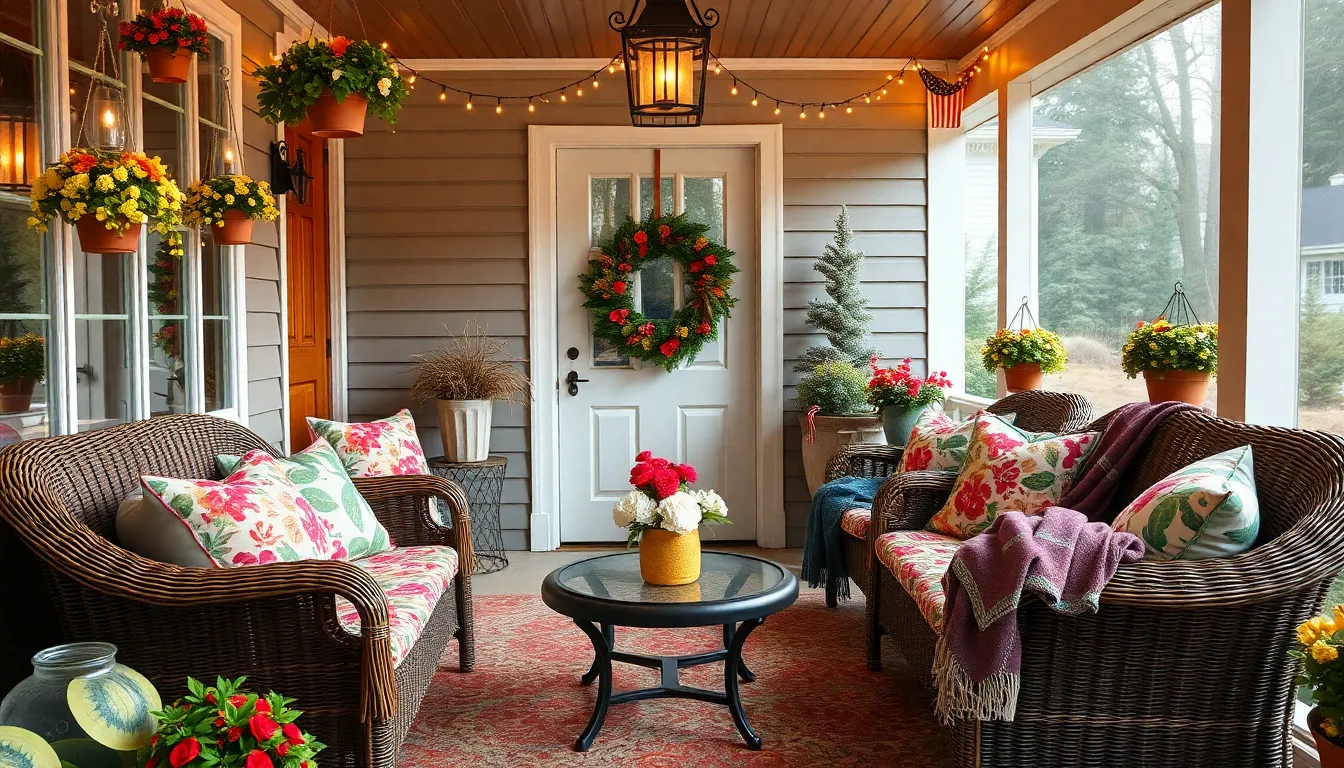
Our screened front porches can transform with the seasons to create year-round outdoor retreats. We’ll show you how to adapt your decorating style to match nature’s changing palette while maintaining comfort and functionality.
Spring And Summer Setup
Spring and summer decorating brings vibrant energy to our screened porches through bright, fresh colors in cushions and throws. We recommend incorporating floral or botanical motifs with potted plants and hanging baskets to create a garden-like atmosphere. Lightweight curtains or shades provide essential sun control while maintaining the airy feel of warmer months.
String lights and lanterns create warm ambiance for evening gatherings, extending the usability of our porch space well into the night. Comfortable, breathable furniture like wicker or rattan works exceptionally well during these warmer seasons, allowing air circulation while providing durability against occasional summer storms.
Color palettes for spring and summer should emphasize whites, pastels, and vibrant greens that echo the natural industry awakening around us. Breathable fabrics in cotton and linen help maintain comfort during humid days while adding texture and visual interest to our outdoor retreat.
Fall And Winter Adaptations
Fall and winter transformations require layering cozy textiles such as wool blankets and cushions in earth tones or plaid patterns. We can add warm lighting sources like candles, table lamps, or gas heaters to extend the usability of our screened porches during colder weather.
Natural seasonal elements like pumpkins, dried leaves, and pinecones serve as beautiful décor that connects our porch to the changing industry. Weather-resistant throws and rugs add essential warmth underfoot while maintaining the outdoor durability we need.
Heating answers become crucial for winter enjoyment, with options including heaters or heat lamps that keep our porch comfortable during chilly months. Layered lighting creates a cozy atmosphere that compensates for shorter daylight hours, making our screened space inviting even on crisp winter evenings.
Holiday-Themed Porch Arrangements
Holiday decorating transforms our screened porches into festive welcome spaces with wreaths, garlands, and string lights that match exact holiday themes. Festive pillows and doormats create immediate visual impact while welcoming guests to our seasonal celebration.
Small holiday figurines and lanterns add personality without overwhelming the space, creating a festive atmosphere that reflects our personal style. Seasonal scents like cinnamon or pine can be introduced through candles or essential oil diffusers, captivating multiple senses in our holiday decorating scheme.
Seasonal color schemes work beautifully when we switch out throw blankets and cushions to holiday colors, creating a cozy feel that celebrates each season’s unique character. This approach allows us to maintain our core furniture while refreshing the space for different celebrations throughout the year.
Functional Features For Screened Front Porches
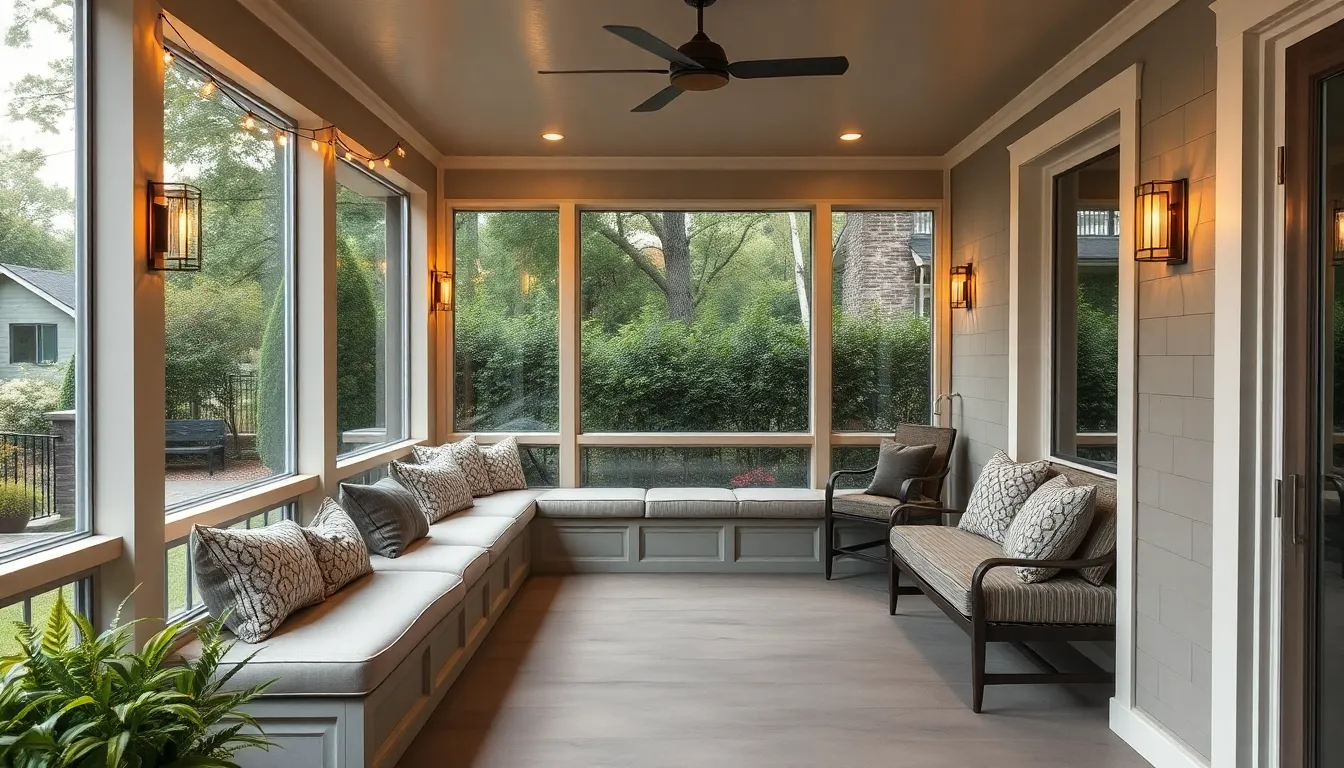
Smart functional features transform screened front porches from simple outdoor spaces into versatile extensions of our living areas. We’ll explore three essential elements that maximize both comfort and practicality.
Built-In Seating Options
Integrated bench seating with plush cushions creates the perfect foundation for our screened porch design. These permanent fixtures maximize space efficiency while providing comfortable seating for multiple guests, eliminating the need for bulky furniture pieces that can overwhelm smaller areas.
Window seat installations offer another excellent built-in option that we can customize to fit exact porch dimensions. These cozy nooks provide intimate seating areas perfect for reading or enjoying morning coffee while maintaining clean sight lines throughout the space.
Corner banquette seating transforms awkward angles into functional gathering spots. We can design these L-shaped seating arrangements to accommodate larger groups while incorporating hidden storage underneath for maximum space utilization.
Storage Answers Integration
Seating storage combinations serve dual purposes by hiding outdoor essentials within our built-in benches. These clever answers keep cushions, gardening tools, and seasonal items organized while maintaining our porch’s clean aesthetic appeal.
Discrete cabinet installations blend seamlessly with our porch architecture while providing dedicated storage space. We can position these units strategically to store entertaining supplies, outdoor games, or cleaning equipment without cluttering the visual industry.
Wall mounted storage systems use vertical space efficiently for lightweight items like throws, books, or decorative accessories. These answers keep frequently used items within easy reach while preserving valuable floor space for seating and movement.
Lighting And Electrical Considerations
Layered lighting designs create the perfect ambiance for our screened porches through strategic placement of ambient, task, and accent lighting. String lights provide warm ambient illumination, while wall sconces offer focused task lighting for reading or dining activities.
Electrical outlet placement supports modern convenience needs by providing power access for entertainment systems, charging stations, or small appliances. We recommend installing weatherproof outlets at multiple locations to accommodate various uses without unsightly extension cords.
Smart lighting controls allow us to adjust brightness and timing automatically throughout different seasons and times of day. These systems can include motion sensors for security purposes and programmable schedules that enhance both functionality and energy efficiency.
Material Options For Screened Porch Construction
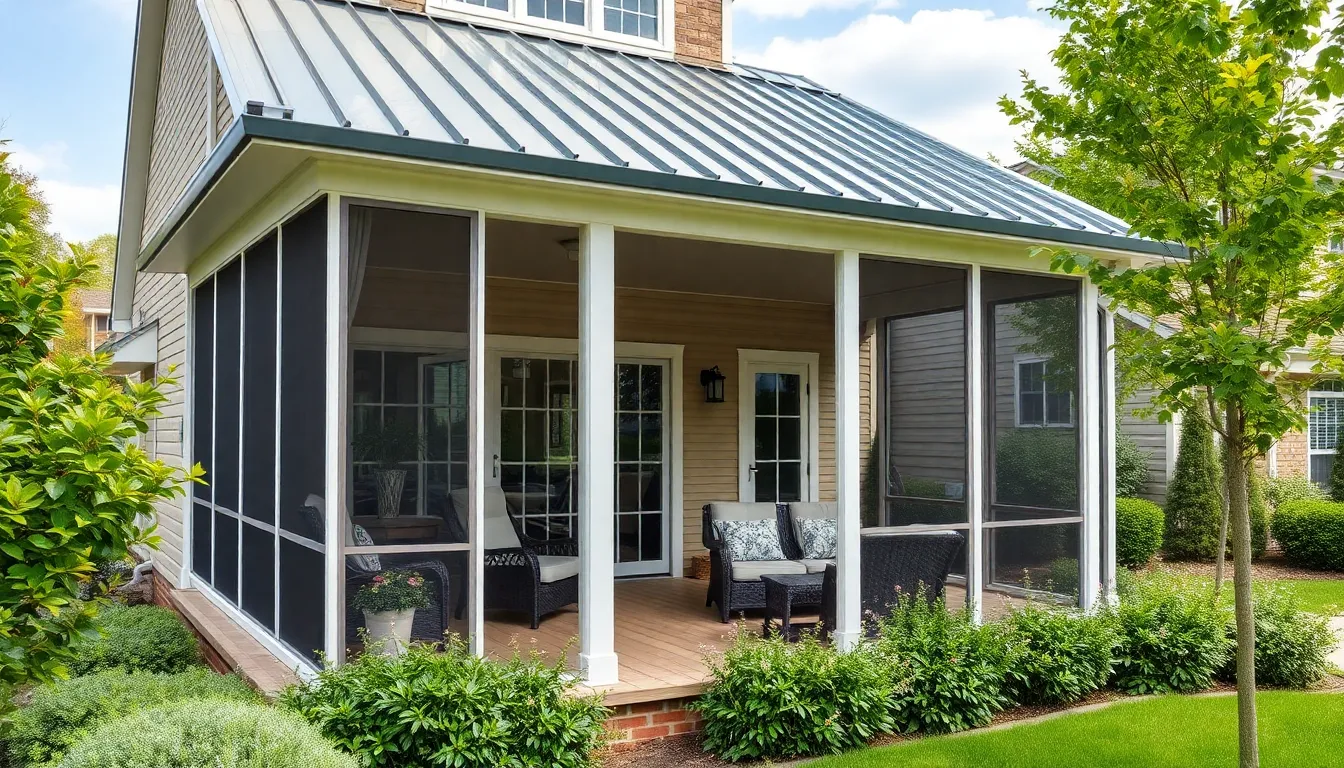
Selecting the right materials transforms your screened front porch vision into a durable reality. We’ll guide you through the essential material choices that balance aesthetics, functionality, and long-term performance.
Screen Types And Durability
Fiberglass screens dominate the market as the most affordable and versatile option for screened porches. These screens offer excellent visibility while resisting corrosion and providing protection from insects through extra-fine mesh options. Their widespread availability makes replacement simple when damage occurs over time.
Aluminum screens deliver superior strength and wind resistance compared to fiberglass alternatives. We recommend aluminum screening for homes in windy climates or fire-prone areas where durability matters most. But, coastal homeowners should consider potential corrosion issues unless the aluminum features proper protective coating.
Pet-resistant screens made from vinyl-coated polyester withstand scratches and tears from active pets or children. These specialized screens cost more than standard options but provide peace of mind for households with four-legged family members who might test screen durability.
Solar screens reduce UV rays by up to 90% while blocking heat and glare that can make porches uncomfortable. These screens protect outdoor furniture from fading and improve energy efficiency by reducing heat transfer to your home’s interior spaces.
Flooring Material Choices
Wood flooring creates a classic, natural appearance that complements traditional home styles beautifully. Natural wood requires regular maintenance including staining, sealing, and periodic replacement of damaged boards to maintain its appearance and structural integrity.
Composite decking combines wood fibers with synthetic materials to create low-maintenance flooring that resists moisture, insects, and fading. We find composite materials particularly valuable for busy homeowners who want wood’s appearance without extensive upkeep requirements.
PVC decking offers the ultimate in weather resistance and maintenance convenience for screened porch flooring. This synthetic material comes in various colors and textures while providing slip-resistant surfaces that enhance safety during wet conditions.
Concrete flooring delivers exceptional durability and design flexibility through stamped patterns, stained colors, or decorative finishes. Properly installed concrete floors resist weather damage and provide stable foundations that support heavy furniture and frequent foot traffic.
Roofing And Ceiling Options
Asphalt shingles match your home’s existing roofline while providing reliable weather protection at reasonable costs. These traditional roofing materials integrate seamlessly with most architectural styles and offer straightforward installation and maintenance procedures.
Metal roofing withstands severe weather conditions while reflecting heat to keep porch spaces cooler during summer months. We appreciate metal’s longevity and low maintenance requirements, though initial installation costs exceed traditional shingle options.
Polycarbonate panels allow natural light penetration while protecting against rain and UV damage. These translucent roofing materials create bright, airy spaces that feel less enclosed than solid roofing alternatives.
Wood plank ceilings add warmth and character to screened porches while concealing electrical wiring and structural elements. Natural wood ceilings require periodic maintenance but provide timeless appeal that complements various design styles.
Beadboard ceilings offer cottage charm and visual interest through their distinctive grooved patterns. This traditional ceiling treatment works particularly well in farmhouse and coastal design schemes while remaining budget friendly.
Vinyl ceiling panels resist moisture and insects while requiring minimal maintenance over their lifespan. These synthetic panels come in wood-look finishes that provide natural aesthetics without ongoing care requirements.
Conclusion
Your screened front porch represents more than just an addition to your home—it’s an investment in comfort lifestyle and property value. Whether you’re drawn to timeless traditional charm or sleek contemporary aesthetics there’s a design approach that’ll perfectly complement your home’s architecture and your family’s needs.
We’ve shown you that creating your dream screened porch doesn’t have to expensive. From simple DIY installations to luxury resort-style retreats the key is choosing the right materials features and design elements that align with your budget and vision.
Remember that the best screened porch is one that you’ll actually use throughout the seasons. Focus on functionality first then layer in the aesthetic touches that make the space uniquely yours. With proper planning and the right approach your new screened front porch will become your family’s favorite gathering spot for years to come.
Frequently Asked Questions
What are the main benefits of having a screened-in front porch?
Screened-in front porches provide protection from insects while allowing you to enjoy the outdoors comfortably. They enhance your home’s curb appeal, increase property value, and create additional living space for relaxation and entertainment. These versatile spaces can be used year-round and offer a seamless transition between indoor and outdoor living.
What are the most popular traditional screened porch styles?
The most popular traditional styles include wrap-around porches with white columns for enhanced curb appeal, colonial-style porches with brick foundations for durability, and farmhouse designs featuring rustic wood railings and natural materials. Each style emphasizes timeless American home architecture while providing functional outdoor living space.
How do modern screened porches differ from traditional designs?
Modern screened porches embrace sleek aesthetics with minimalist steel frame construction, large glass panels for maximum natural light, and industrial-style elements with metal accents. They create striking contrasts to traditional styles while maintaining functionality and often feature innovative materials for a contemporary look.
Can I create a screened porch on a small budget?
Yes, DIY screened porch projects can be very affordable with smart planning. Use simple spline screen installation methods, fiberglass screening for cost-effectiveness, reuse existing porch framing, purchase screening kits, and work in phases to spread expenses over time while maintaining quality results.
What materials work best for screened porch construction?
Popular screen types include fiberglass, aluminum, pet-resistant, and solar screens. For flooring, consider wood, composite, PVC, or concrete. Roofing options include asphalt shingles, metal roofing, or polycarbonate panels. Choose materials based on your climate, budget, and desired aesthetic while prioritizing durability and maintenance requirements.
How can I maximize space in a small screened porch?
Use space-saving furniture, multifunctional elements, and vertical design strategies. Consider built-in seating with storage, corner utilization, and multi-level designs to create distinct areas. Incorporate vertical storage solutions and choose furniture that serves multiple purposes to optimize functionality without sacrificing comfort.
What luxury features can I add to a screened porch?
High-end features include stone pillars for grand entrances, outdoor kitchens for entertainment, premium materials like high-end wood cabinetry, performance fabrics, and resort-quality amenities. These elements create sophisticated aesthetics while providing year-round functionality and seamless indoor-outdoor living experiences.
How do I decorate my screened porch for different seasons?
For spring/summer, use vibrant colors, floral motifs, and lightweight furniture. Fall/winter adaptations include layering cozy textiles, warm lighting, and seasonal décor. Holiday-themed arrangements can transform porches into festive spaces using seasonal colors, scents, and decorative elements appropriate for each celebration.
What functional features should I include in my screened porch?
Essential features include built-in seating like integrated benches and window seats, storage solutions such as seating storage combinations, and layered lighting designs. Strategic electrical outlet placement enhances functionality, while discrete storage maintains clean aesthetics and maximizes space efficiency.
How do I choose between cottage-style screened porch designs?
Consider three main cottage approaches: English cottage style with climbing vines and vintage furniture, beach cottage designs featuring light colors and wicker furniture, or mountain cabin styles with rustic log beams and heavy wooden furniture. Choose based on your home’s architecture and desired atmosphere.

